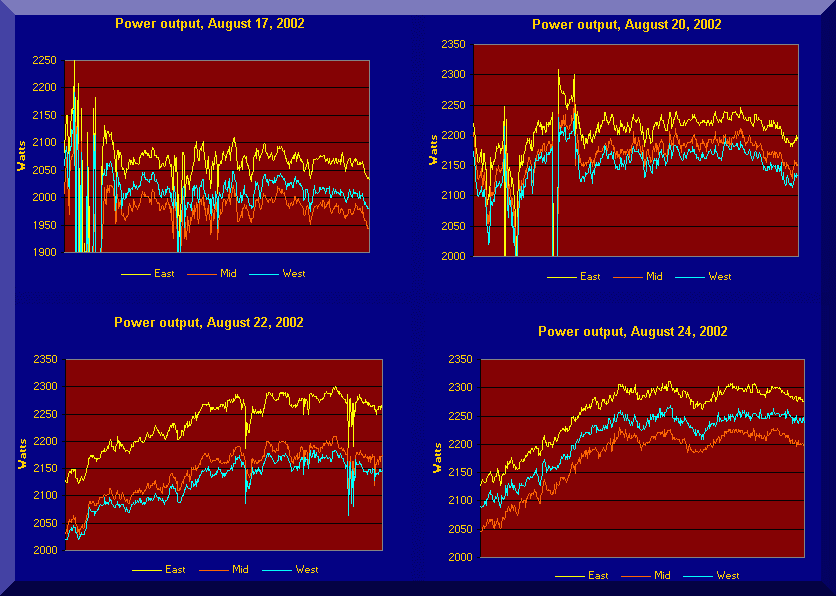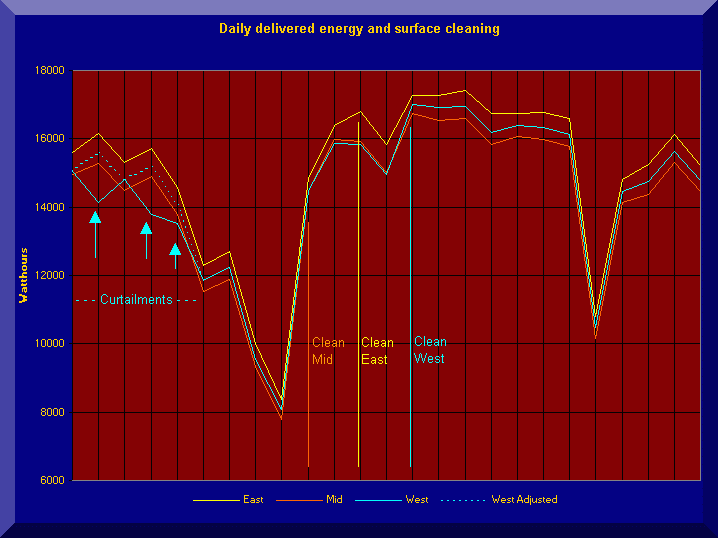A week or so after installing my photovoltaic
plant I began to wonder about the effects of dust accumulating on the
panel surfaces. So I devised an experiment
to quantify the degradation.
|
|
I allowed the surfaces to
accumulate dust for six weeks in preparation for the experiment. More detrimental soil, such as bird droppings, were promptly removed.
Originally the array consisted of four sub-arrays, each with its own
inverter. I recently replace the original inverters and in doing
so reorganized the array into three equal sub-arrays, each with six bays
of four panels.
|
My approach to quantifying the dust extinction factor
I know no way to quantify the degree of surface soil other than to state the
six-week
period and include a photograph that shows before and
after. The
picture also reveals where the dust originates (our drought-ravaged
soil). The distant six bays (West) and the nearest six bays (East)
are unwashed. Click on the thumbnail to see a larger image. and include a photograph that shows before and
after. The
picture also reveals where the dust originates (our drought-ravaged
soil). The distant six bays (West) and the nearest six bays (East)
are unwashed. Click on the thumbnail to see a larger image.
The experiment is based on selectively cleaning a sub-array and
observing its relative performance before and after cleaning. The
West sub-array was the reference control for the Mid and East
sub-arrays, and the East sub-array was the reference control for the
West sub-array.
|
The raw data
Below are four charts of instantaneous output power for each
sub-array over a two-hour period around solar noon. The sample
rate was 4 times per minute. The earliest, August 17, shows
performance before any cleaning was done. August 20 shows
performance on the day the Mid
sub-array was cleaned. August 22 shows the East
cleaning, and August 24 shows the West
cleaning. Cleaning was quickly done
at sunrise. |

|
| Examining the charts, note how the Mid
sub-array output moved above West on
August 20, the day it was cleaned. Then East
widens its lead over Mid and West
on August 22. Finally on August 24 West
regains its superiority over Mid and the relative ranks are as they were
before cleaning. Perhaps a more meaningful presentation is shown below.
During the
first five days of the chart, the west sub-array suffered some
curtailments, reportedly because the inverter sensed a grid frequency
disturbance. The broken line shows the likely performance for
those days. This was probably a malfunction since the other two
inverters did not curtail. |

The
delivered energy can be seen to improve after each cleaning. It is
difficult to see, but Mid clearly improved relative to
West on the day
it was cleaned. Likewise East shows an increasing slope relative
to Mid and West on its cleaning
day. West, slightly below Mid
before cleaning, moved noticeably above after cleaning.
|
Determining an improvement value
While the above charts clearly indicate that cleaning begat
improvement, the degree of the improvement is not well expressed. Below is another chart to help assess this.
The calculations get a bit tricky when a control sub-array is cleaned.
I applied a factor to compensate for the
increased output of the control reference. A 2-day delay between
sub-array cleanings provided an alignment spline to determine the factor.
Absolute accuracy is not the goal here, rather it
is relative performance before and after cleaning. In every case
the clean-day transitions were bounded before and after by an
undisturbed reference control. |
 |
| Here is shown the relative delivered energy,
before and after cleaning, for each sub-array referenced to the output of a different
sub-array. West acted as control for Mid and East, and East was the control for
West. The broken lines are running average trendlines for the
sub-arrays.
This has been a difficult evaluation, and by no means a precise one. But from the chart above it seems reasonable to state that
cleaning produced an improvement of between 2-1/2% and 3%. With
only six weeks of soil accumulation, one might deduce that a much longer
exposure period would accumulate enough soil to significantly reduce
performance. But I also suspect that my array, due to its
location, accumulates soil faster than a rooftop array would. I'm always happy to hear from anyone with an opinion on
solar subjects. If you have one that you'd care to share, please
do so with an entry in our Guest
Book. |